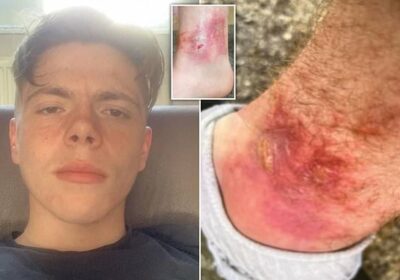Brothers, 21 and eight, suffer horrendous burns from giant hogweed

Brothers, 21 and eight, suffer horrendous burns when they brush against giant hogweed in park – with older lad suffering golf ball-sized blisters that left him barely able to walk
- Daniel was playing football in the park with his little brother and went to get ball
- At first, he thought he was stung by a nettle and rubbed his leg with dock leaves
- But it was actually hogweed which is UK’s ‘most dangerous plant’ causing burns
A young man was left with blisters the size of gold balls that will scar for life after he and his little brother touched Britain’s ‘most dangerous plant’.
Daniel, 21, brushed past the dreaded giant hogweed while retrieving a football from a bush in Boston Manor Park, Brentford, West London.
Thinking he’d been stung by a nettle, he rubbed his ankle with a dock leaf and continued to enjoy the summer sunshine.
But his eight-year-old brother, Stanley, had been burned too, leaving the brothers with blisters and Daniel barely able to walk.
‘I jumped into the bush, got the football out, and stung my ankles. I thought it was stinging nettles,’ said Daniel.
Pictured, Daniel, 21, could be scarred for life after getting blisters the size of golf balls on his leg
The brothers thought they had been stung by nettles initially and rubbed dock leaves on themselves
‘My nan got me a dock leaf to rub on it, and I rubbed it on, and it got a little bit better.
‘So the next two days I chilled and went to work like normal, thinking nothing of it because I thought it was a stinging nettle rash.
‘Then two days later it just came up in massive blisters and it was so painful that at one point I couldn’t even walk.
‘I got out of bed in the morning for work and I collapsed under my own weight.’
The giant hogweed’s sap stops the skin from protecting itself against the sun’s rays, leading to gruesome burns when exposed to natural light.
The giant hogweed’s sap stops the skin from protecting itself against the sun’s rays which can cause severe burns
READ MORE: Is TOXIC giant hogweed growing near you? Interactive map reveals hotspots for the ‘most dangerous plant in UK’
What makes it so dangerous is that it usually causes no immediate pain, so its victims can continue to burn in the sunshine unaware of any problem and it only takes a moment of exposure for the sap to do its work.
Daniel said his blisters grew as big as ‘golf balls’ and caused ‘unbearable’ pain.
He ended up being sent home from work early and needed two further days off to recuperate.
He said: ‘For two days after I got stung by the plant, I was working with my ankles out in the sun because it was really hot, and that’s why they’ve blistered up so bad.’
Although it was less severe for Stanley, it was ‘still not pretty’ said mum, Jenny.
She added: ‘My other son who got hurt, he’d had a leaf in his hand.
‘Obviously we’d got the dock leaves so he just picked a leaf too and unfortunately it was this hogweed leaf.
‘He had three very small blisters, they were like burn lines on his hands.
‘He’s scarred as well and I’m hoping that it’s not a lifelong scar.’
But unfortunately, Daniel said he is going to be scarred ‘for the rest of my life’.
‘To be honest, I don’t even know when I can uncover my ankle.
Pictured, Daniel and Stanley together. Luckily, the eight-year-old’s injuries were not as bad as his older brother’s
Daniel said, ‘I got out of bed in the morning for work and I collapsed under my own weight’
Mike Duddy, of the Mersey Basin Rivers Trust, said in 2015 that the giant hogweed was ‘without a shadow of a doubt, the most dangerous plant in Britain’
READ MORE: What does giant hogweed look like? Gardening expert explains how to spot it – and how to rid of it
‘I’m scared to have it out in the sun because I don’t want that to happen again.
‘I can’t let no sun through otherwise I end up with third-degree burns, and that’s what it basically was, that’s what’s happened to me.’
Now the family are calling for parks to put up warning signs about the dangers of giant hogweed.
Jenny continued: ‘If I would have known that there was anything like that in that park or if there were any warning signs, I would not have let the kids go anywhere near the bush.
‘It took literally seconds. I think that’s what Daniel is most fuming about: if he would have known the dangers, then it could have been completely avoided and he wouldn’t be scarred for life.’
Daniel added: ‘I’m 21 years old, and I’m alright if something like that happens to my ankle.
‘But if a five-year-old tried to get a ball and fell into that bush, and fell face first, they’d get life-changing injuries.’
The giant hogweed is native to the Caucasus but was introduced to Britain as an ornamental plant in 1817 before it spread and got out of control.
Mike Duddy, of the Mersey Basin Rivers Trust, said in 2015 that the giant hogweed was ‘without a shadow of a doubt, the most dangerous plant in Britain’.
If exposed to the plant, you should thoroughly wash the area that made contact and keep it out of sunlight for a few days, the Woodland Trust advises.
The London Borough of Hounslow, which manages the park, has been contacted for comment.
Source: Read Full Article





